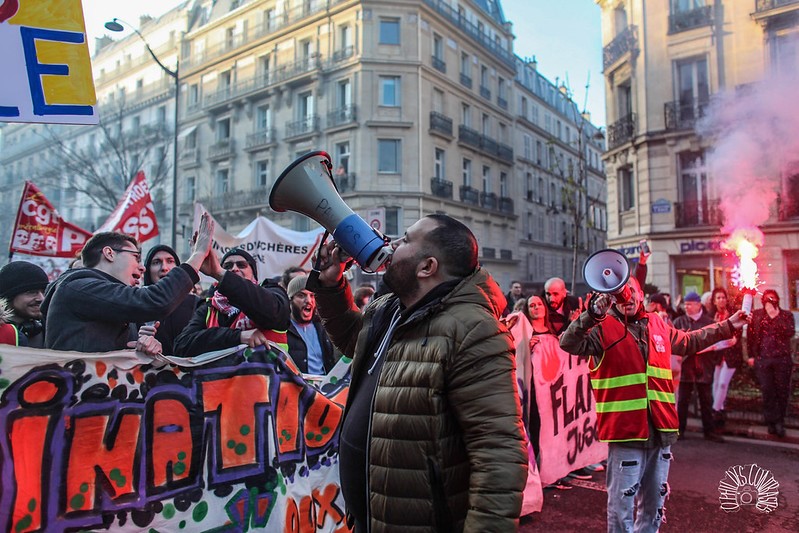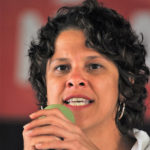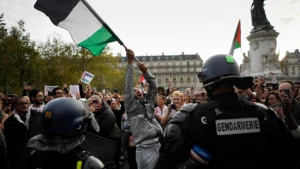On January 17, a new player burst into the media spotlight — the RATP-SNCF Coordinating Committee. It was immediately accused by Laurent Berger, secretary-general of the CFDT, of being responsible for the action that targeted the headquarters of his trade union.1Translator’s note: The Confédération française démocratique du travail (French Democratic Confederation of Labor) is one of France’s two largest trade union federations, led by one of the most pro-employer bureaucracies. The “action” is a reference to a militant workers’ protest at the CFDT headquarters in January. But what is the origin and nature of this organization that has become the expression in the Paris region Ile-de-France of the radicalized base of the state passenger railroad company SNCF and, above all, the Paris public transit company RATP?
Although the group did not have a name before then, its actions garnered lots of publicity, especially during the end-of-the-year holiday period when strikers were left to their own devices by their union leaders: a rally at RATP headquarters on December 23, followed by a surprise action at the Gare de Lyon [train station in Paris] that ended up paralyzing traffic on one of the metro’s two automated lines; a march of than 3,000 people from the Gare de l’Est to the Gare Saint-Lazare [Paris train stations], called and organized from start to finish by the strikers themselves on December 26; an action at the main office of La République En Marche (LREM)2Translator’s note: La République En Marche is the political party of French President Emmanuel Macron. on January 2; a protest on January 15 at the headquarters of Derichebourg Group in solidarity with Adama Cissé, who had been unfairly fired3Translator’s note: Derichebourg is an environmental services company that provides cleaners for public spaces in Paris; Cissé was fired in late 2018 after a photograph of him resting on the job was circulated, and he sued the company in a case heard on January 15.; and an action at the CFDT headquarters on January 17.
But the scope of this Coordinating Committee goes far beyond organizing “lightning actions.” It is one of the strikers’ most important experiences of self-organization and workers’ democracy, independent of their trade union organizations. It is the most far-reaching since the experience of coordinating committees among railway workers and nurses in the latter half of the 1980s.
At its best moments, this Coordinating Committee has succeeded in bringing together representatives (and often some of the leaders) from about 15 bus depots, two RER lines [a hybrid commuter rail-subway line] and five metro lines, in addition to several stations and important sectors of the SNCF in the Paris region, which makes it a key player in the mobilization in the area.
And It All Began on September 13 …
The starting point of this story and of the entire sequence we are still going through is undoubtedly September 13, 2019, a day of mobilization confined to the RATP but that “set the record straight” — to use the expression of some of the strikers. Everyone expected a confrontation to come much later, after the public release of the pension reform bill. But that didn’t account for a return to the method of the strike — regardless of the objective difficulties that might have arisen due to lack of support by union leaders — which had been discredited by a series of defeats and poorly led battles and that had, among other things, led the Yellow Vests to reject it in part. Nevertheless, at the RATP in September, a walkout of more than 90% of the workers demonstrated the effectiveness of a mass strike — directly contradicting the claim of former President Nicolas Sarkozy in 2008 that “when there is a strike, nobody notices it.”
And they didn’t stop there. That very day, at a rally at the RATP headquarters, their battle plan was synthesized in the slogan they shouted into the ears of their union leaders: : “Unlimited strike in December! Unlimited strike in December!” The December 5 date then set by the unions thus reflected, in part, the pressure of the rank and file (after a moment of hesitation on the part of the CGT trade union federation’s RATP leaders4Translator’s note: The Confédération générale du travail (General Confederation of Labor) is one of France’s two largest trade union federations.). From that moment on, the December 5 date gradually became set in stone.
The RATP strike on September 13 also had a strong impact at the SNCF, where the bitter taste of defeat in the strike against the 2018 Railway Pact lingered. For very concrete reasons, employees of these two companies feel bound together, often because they are basically working in the same profession, but sometimes because they even work together (such as on the sections of the RER lines they co-maintain). The feeling for what the Yellow Vests had gone through was palpable, and this very quickly found an echo at the SNCF in the deep tremors reflected in the national right of withdrawal for drivers/conductors following the accident in Champagne-Ardenne5Translator’s note: In mid-October 2019, a TER strain struck a road convoy stuck on a crossing, causing many injuries — including the driver. Within days, upwards of 17,000 drivers/conductors refused to keep working, citing their “right of withdrawal” under the French Labor Code to cease working in any situation considered to be a serious and imminent danger to their life or health. The company and government called it a “wildcat strike.” or the “wildcat” strike in the Technicentre in Châtillon.6Translator’s note: In late October, hundreds of rail workers at the Châtillon rail yard went on strike in open defiance of restrictions imposed during the unions’ negotiations, shutting down about two-thirds of the high-speed trains on France’s western Atlantic network (TGV-Atlantique).
Origins of the Coordinating Committee: A Facebook Group and the RATP-SNCF Meetings
It is in this context that contacts were established very quickly between RATP and SNCF employees in the Paris region, in anticipation of the unlimited strike that would begin on December 5. This first took place on Facebook, with the creation of a group called RATP-SNCF agents, l’union fait la force (“RATP-SNCF agents: unity is strength”), which was the venue for the initial exchanges, before a first meeting was held in Saint-Denis on October 16. It had been proposed by the railway workers grouped around the Intergares [Inter-station] collective, which had been formed after the 2018 strike against the Railway Pact.
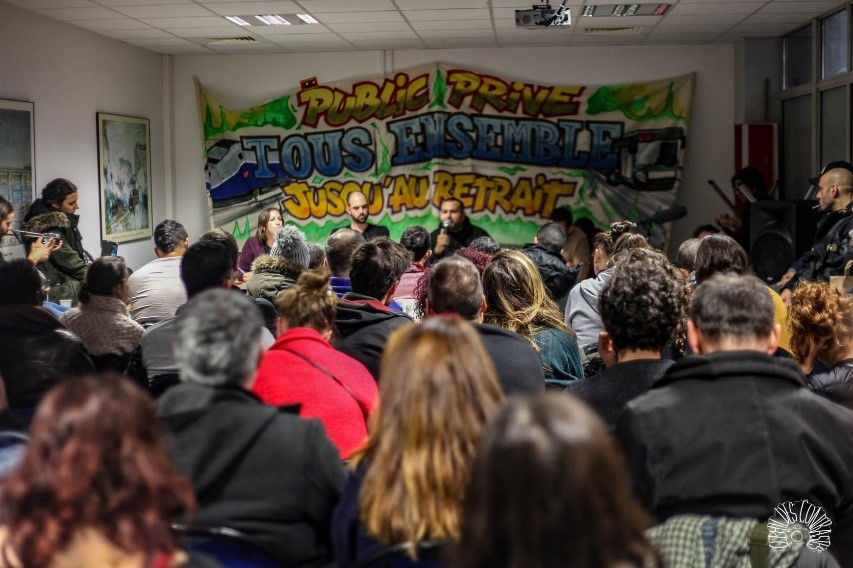
There were three of these “RATP-SNCF meetings” in October and November. They constituted a sort of embryo of coordination, enabling links to be forged and joint work to be commenced in preparation for the December strike.
This work was constituted on the basis of extremely clear positions on the need to fight for the complete withdrawal of Macron’s pension reform and the fact that the rank and file should continue to impose its agenda on the union leaders, but above all by patient work to educate their colleagues, through joint tours by RATP and SNCF employees, who from the third meeting onward were joined by teachers.
These meetings continued to take place once the strike began, with the first one on December 6 and others in the weeks that followed. Up until that point, they brought together a relatively limited number of sectors, particularly those in which part of the extreme Left had militants and contacts.
The December 20 Turning Point
It was only at the end of December that these meetings took a leap forward and a framework emerged that began to resemble a real coordinating group of strikers. On December 19, after a negotiating session with the government, the union confederations decided to call a holiday truce in the strike. This position was made explicit by the CFDT and UNSA7Translator’s note: The Union nationale des syndicats autonomes (USNA, National Union of Autonomous Trade Unions), is a small trade union confederation in France mostly based among white-collar workers. and was implicit with respect to the CGT. Without mentioning the word “truce,” CGT Secretary General Philippe Martinez declared that day, in front of Matignon, the official residence of the French prime minister, that unions would “meet on January 9 for a new day of inter-branch action.”
The news was like a cold shower for the SNCF and RATP strikers, who had already logged two weeks of open-ended strike and who very quickly understood that a truce would concretely mean the end of their movement.
Anasse Kazib, a railway worker at Le Bourget who had been a figure in the movement against the 2018 Railway Pact, had become an example for many strikers, thanks in part to some notable media coverage in which he dissected all the attacks contained in the Delevoye report that would serve as the basis for the reform project.8Translator’s note: Jean-Paul Delevoye had been the high commissioner in charge of the French pension system reform before resigning in a scandal over undeclared income on December 16, 2019. That same evening, Kazib announced that he would be doing a live stream broadcast on the Facebook page of Révolution Permanent9Translator’s note: The French sister newspaper of Left Voice. to discuss the ongoing betrayal by the union leaders and the aftermath of the movement, and that he would be making a direct appeal to strikers from several sectors.
The live stream was a huge success, with more than 4,000 people logging in. Tens of thousands watched on replay in the days that followed. The opinion of the rank and file was clear: no one wanted the unions to call a truce! Anasse Kazib proposed on the live stream that a physical meeting be held the next day to discuss a battle plan for holding on through the holidays.
All of a sudden, the idea of rank-and-file coordination of the strike, which until then had appeared to most people as “the political activists’ thing,” became an urgent need in the eyes of all, an indispensable tool to impose the will of the strikers and the continuation of the movement despite the position taken by the union leadership.
The Union Truce and the Emergence of the Rank and File
That subsequent meeting was also a success. More than a hundred strikers met in a basement room provided by comrades from SUD-Rail Paris Saint-Lazare, along with representatives of more than a dozen bus depots, RER A and B trains, a few metro lines, and several sectors of the SNCF. In an atmosphere of open exchange, the strikers worked out their own agenda for the first week of the holidays, with actions to raise public awareness and collect money for the strike funds in shopping centers over the December 21–22 weekend, a rally in front of RATP headquarters on Monday, December 23 to denounce the repression that was raining down on the bus depot pickets, and a self-organized demonstration by the strikers on Thursday, December 26.
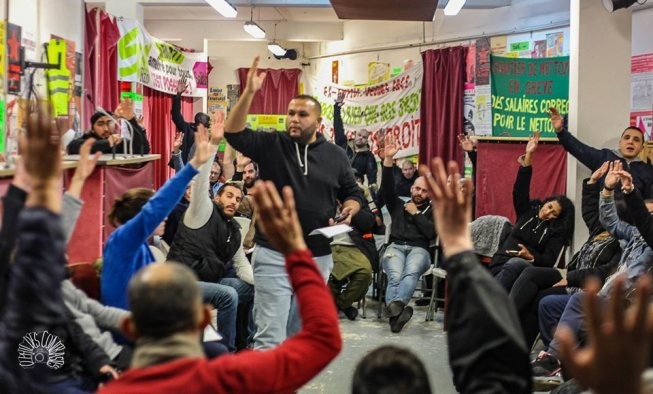
The rally on December 23 brought together several thousand people, before turning into a “lightning action” at the Gare de Lyon and for a few hours paralyzing traffic on Metro Line 1, one of the two automated lines operating during the strike.
That day, the press was dumbfounded to discover a force that had been erased from the media for two weeks. It was lurking behind the union confederations’ calls for a truce: the rank and file of the strike. It was a rank and file not only determined to prevent the suspension of the movement, but on the contrary to radicalize it! One expression of this combative spirit: surrounded by police outside the train station, railway workers and RATP agents didn’t flinch and broke through the police lines, cheered on by their colleagues and supporters.
After holidays spent between families and pickets, the fledgling Coordinating Committee returned to the streets on Boxing Day, with a march between the Gare de l’Est and the Gare Saint-Lazare. The idea had come from an RATP agent who, during the Facebook live stream on December 19, asked Anasse Kazib whether it would be possible for the strikers to organize their own demonstration independent of the trade unions. The meeting on December 20 decided to take this on and, with logistical support from the SUD-Rail workers (filing the route with the local authorities; lending a van with a sound system), the march was on.
More than 3,000 people came out in response to the call for this combative demonstration, in which the strikers themselves took on all the tasks, from security to leading the march. The speeches at the end of the march were proof of the pride in that success. As Karim, from the Pavillon-sous-Bois depot, declared: “Today it was the rank and file that spoke. It was the rank and file in the street. And frankly, we showed that we are as mobilized as ever and that we will go all the way!”
The demonstration also significantly bridged the gap with the Yellow Vests, many of whom took part. Yellow Vest leader Jérôme Rodrigues also took the microphone to salute the strikers’ initiative: “Bravo to you. You don’t need your leaders. You don’t need your confederations. Today, you are like the ‘Yellow Vest’ voice that makes itself heard in the streets.” He then called for convergence not only against pension reform but to “overthrow this system.”
Nevertheless, the Coordinating Committee never saw itself as an anti-union framework, which is why it called on the marchers to join the Ile-de-France trade union coalition demonstration scheduled for two days later.
Strikers Have Their Say
But the Coordinating Committee did not limit itself to organizing “punch” actions, even though they were an important part of boosting striker morale and showing the media — and through them other workers all over the country — that the movement was continuing and that there would be no truce. It also gave a voice to the rank-and-file strikers, to all those who were still holding daily pickets and general meetings.
Anasse became a de facto spokesperson for the Coordinating Committee, not only speaking to the media at actions but also directly confronting government representatives on television, who often found it quite difficult to counter his arguments — which were backed by the determination of the strikers and Anasse’s mastery of the Delevoye report recommendations that often far exceeded the very LREM deputies who were supposed to defend the reform project.
The desire to give the strikers a voice could not be limited to that, however, which is why the Coordinating Committee organized several press conferences. The first one took the form of the strikers’ response to Macron’s New Year’s speech. In a café in the north of Paris and in front of the press, they addressed “first all the users of public transit who, as we know, are affected by the president’s ‘rotting’ strategy” before committing to continue to fight in 2020 “against this reform, which offers nothing but a world of precariousness to the working population and future generations” and calling on “all sectors, private and public, as well as young people, to join us in the fight.”
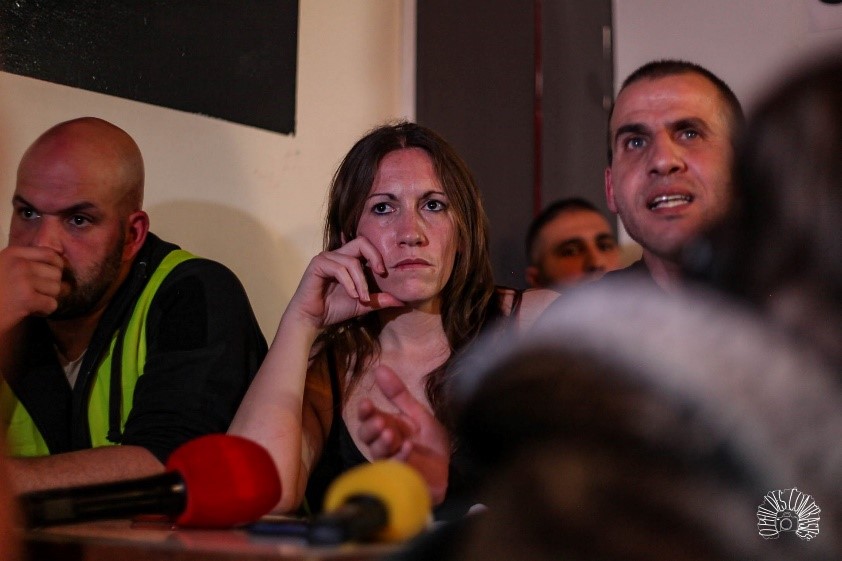
The Coordinating Committee held other press conferences to denounce the repression during the January 9 demonstration and the disciplinary action taken against striking workers, and then to respond to the attacks by the government and the trade union confederations following the action at the CFDT headquarters.
A Tool for Organizing the Strike, Extending It, and Combating Repression
The Coordinating Committee also proved to be an effective tool for organizing and coordinating the strike itself, especially during the difficult end-of-the-year-holidays period when the picket lines at bus depots were deprived of much of the support they had enjoyed other mornings. A decision was made to adopt rotating pickets as a tactic: each day, the strikers and their supporters concentrated on two bus depots, one each in the north and south Paris region. They often managed to block the buses from leaving, either with the picket itself or because the depot management would call in police repression that non-striking colleagues couldn’t tolerate and who would then exercise their right of withdrawal from work.
The Coordinating Committee didn’t limit itself to organizing strikers at the two companies, but initiated meetings with many sectors, in universities, within the national public school system, and even in the private sector, with delegations organized to go to Total’s refinery in Grandpuits and PSA’s auto plant in Poissy, Yvelines.
The Coordinating Committee has also been important in countering employer and police repression against strikers and their supporters. Each time a striker was taken into custody, the Coordinating Committee organized rallies in front of the police station until their colleague was released. Similarly, it has been involved in defending all the RATP employees subjected to disciplinary proceedings for strike-related offenses.
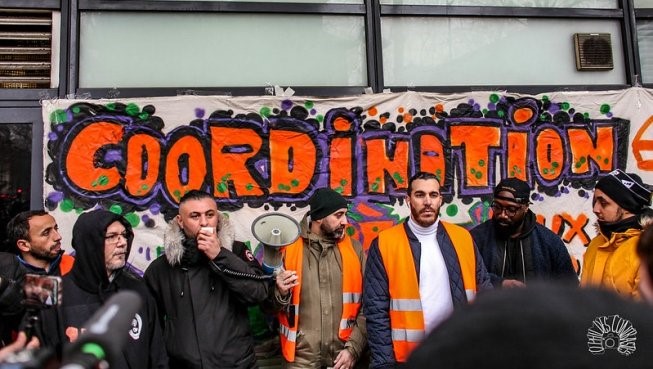
The case of Hani Labidi is emblematic. A main organizer of the strike at the Belliard depot in the capital’s 18th district and an active member of the Coordinating Committee, Hani faced RATP discipline for events that took place prior to the strike. The two mass rallies organized by the Coordinating Committee in front of the RATP building where its disciplinary board was meeting largely contributed to the penalty the company had asked for — a one-month suspension that could be extended to dismissal — being reduced to just a 15-day suspension. In a gesture of solidarity that testifies to the fraternity created between SNCF and RATP strikers within the Coordinating Committee, railway workers at Le Bourget decided to use €500 from their strike fund to help compensate Hani for the loss of wages from that sanction.
Not the Strike Managers, but a Counter-Power from the Striking Rank and File
The RATP-SNCF Coordinating Committee was never in charge of the strike. It would have needed a stronger presence, particularly in the Metro, one of the pillars of the strike. It would have needed a more solid base of general meetings and/or strike committees, but these were limited due to the combination of travel difficulties caused by the strike itself and a lack of experience in a sector that had not had a huge strike for more than 10 years. (It would also have required extending more deeply inside the SNCF, where the control of the union leadership was stronger on the ground.)
Nevertheless, the Coordinating Committee exercised a form of genuine counter-power. Imposing its own agenda during the holiday period and throughout the conflict put real pressure on the union leaders against calling a truce and for resuming the strike. If the media are to be believed, moreover, it was that pressure that forced RATP’s union leaders to agree only to unofficial meetings with the government in the most improbable places [for fear that strikers would show up to protest]. The Coordinating Committee was the conscious and organized expression of this pressure, which greatly restricted management’s room for maneuvers and negotiation, hindering an easy return to work. It thus played a central role in extending the movement beyond December, creating the conditions for other sectors to take over once the resources of the transport strike began to run out, especially from a financial point of view.
Again, it was Karim, the movement’s leader at the Pavillon-sous-Bois depot, who best summed this up in a conversation about the role of the Coordinating Committee: “Without it, the unions would have had a free hand to call for the suspension of the strike at the end of December — and that would have killed the movement.”
Confidence Building, the Emergence of a Militant Core, and the Experience of Workers’ Democracy
This objective assessment of the role played by the RATP-SNCF Coordinating Committee must not, however, erase one of its main achievements — a subjective one. The rank-and-file strikers, among whom were many non-unionized employees, were used to movements led from start to finish by union leaders and to general assemblies that looked just like meetings of union representatives. But the strikers here gained confidence in their own strength and capabilities, in their collective intelligence, and in their ability to learn from each other’s experiences.
Unaccustomed to meetings of this type at the beginning, the strikers on the Coordinating Committee learned to discuss together, argue when they disagreed, and decide according to the majority opinion so that week after week they could come out with a collective battle plan. Over the course of the meetings, the maturation of both the framework and its actors was palpable, with better put-together interventions and real debates on strategy for the movement, the role of the union leadership, and the obstacles to expanding the movement.
It was through this as well that a number of women strikers were able to organize themselves, gaining confidence not only by playing leading roles in the strike in their respective sectors, but also on the Coordinating Committee itself. These include Laura, a railway worker from Le Bourget; Nadia, a machine operator at the Flanders depot; Hanane, a driver on Line 5 of the Metro; and others. These female warriors were able to take the floor, discuss on an equal footing with their male colleagues, and played a role in implementing the committee’s decisions week after week.
The Coordinating Committee thus contributed to the emergence of a solid militant core, aware of the strength of the workers and the role of the union leadership and whose concerns went far beyond the issue of pensions alone.
The emergence of this layer of conscious strikers — real leaders emanating from the rank and file — will be an asset for continuing the battle against pension reform and more generally in the French class struggle.
Knowing How to Organize the Retreat in Order to Be Able to Think About a Return
Let’s not deceive ourselves: today, the transport strike is in a clear ebb, and only a small nucleus continues to strike and to advocate for an extension of the movement to other sectors. Nevertheless, the feeling that reigns among the strikers who participated on the Coordinating Committee is far from one of defeat or demoralization. The strikers understand that while the fight against pension reform is far from over, continuing a strike that has become one of only a minority of the workers and without immediate prospects for victory is not the most effective method of struggle.
Nevertheless, they remain organized to continue to explore possibilities for a massive movement in other sectors (and particularly now among the youth), and to combat the repressive counter-offensive by RATP management, which is expanding its disciplinary procedures. It seeks to generalize the example of the Coordinating Committee to other sectors and regions of the country, with a view to organizing a national meeting to lay out a real battle plan that includes a general strike against the government and its reform. It is a sign that this singular experience of self-organization of our class has not yet had its last word.
First published on February 2 in French on RP Dimanche.
Translation: Scott Cooper
Notes
| ↑1 | Translator’s note: The Confédération française démocratique du travail (French Democratic Confederation of Labor) is one of France’s two largest trade union federations, led by one of the most pro-employer bureaucracies. The “action” is a reference to a militant workers’ protest at the CFDT headquarters in January. |
|---|---|
| ↑2 | Translator’s note: La République En Marche is the political party of French President Emmanuel Macron. |
| ↑3 | Translator’s note: Derichebourg is an environmental services company that provides cleaners for public spaces in Paris; Cissé was fired in late 2018 after a photograph of him resting on the job was circulated, and he sued the company in a case heard on January 15. |
| ↑4 | Translator’s note: The Confédération générale du travail (General Confederation of Labor) is one of France’s two largest trade union federations. |
| ↑5 | Translator’s note: In mid-October 2019, a TER strain struck a road convoy stuck on a crossing, causing many injuries — including the driver. Within days, upwards of 17,000 drivers/conductors refused to keep working, citing their “right of withdrawal” under the French Labor Code to cease working in any situation considered to be a serious and imminent danger to their life or health. The company and government called it a “wildcat strike.” |
| ↑6 | Translator’s note: In late October, hundreds of rail workers at the Châtillon rail yard went on strike in open defiance of restrictions imposed during the unions’ negotiations, shutting down about two-thirds of the high-speed trains on France’s western Atlantic network (TGV-Atlantique). |
| ↑7 | Translator’s note: The Union nationale des syndicats autonomes (USNA, National Union of Autonomous Trade Unions), is a small trade union confederation in France mostly based among white-collar workers. |
| ↑8 | Translator’s note: Jean-Paul Delevoye had been the high commissioner in charge of the French pension system reform before resigning in a scandal over undeclared income on December 16, 2019. |
| ↑9 | Translator’s note: The French sister newspaper of Left Voice. |


